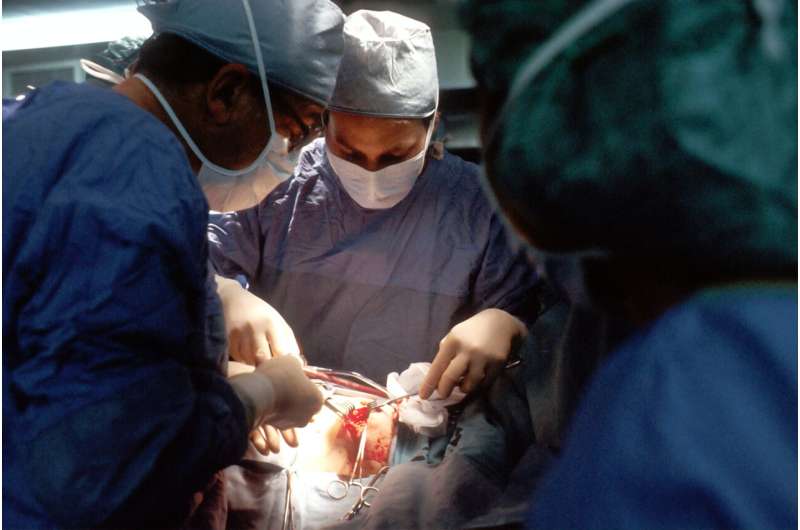This article has been reviewed according to Science X's editorial process and policies. Editors have highlighted the following attributes while ensuring the content's credibility:
fact-checked
peer-reviewed publication
trusted source
proofread
Study highlights disparities in life-saving treatment for stroke after heart surgery

Although stroke treatments have vastly improved in recent years, leading to better outcomes for many, one population of patients often does not receive these effective therapies: those who suffer strokes following heart surgery.
In fact, these patients are less than half as likely as stroke patients who haven't undergone heart surgery to receive what could be lifesaving and disability-preventing treatments, according to a Yale School of Medicine study recently published in JAMA Neurology.
Endovascular thrombectomy, which involves snaking a thin catheter up an artery from the wrist or groin to clear arterial blockages in the brain, is by far the most effective treatment for ischemic strokes, which are the most common form of stroke—caused by a blockage of blood flow to the brain. However, the treatment must be administered in the first 24 hours of symptoms, ideally sooner.
For a variety of reasons, detecting strokes in heart surgery patients this quickly can be tricky. Also, surgery patients are generally not eligible to receive the other major treatment modality for ischemic stroke, intravenous thrombolysis with tissue plasminogen activator (tPA), due to its blood-thinning effects.
To understand whether heart surgery patients are less likely to receive post-operative endovascular treatment if they suffer strokes, Adam de Havenon, MD, a vascular neurologist and associate professor of neurology at Yale School of Medicine, and his colleagues sifted through a nationwide database of stroke patient data from nearly 5,000 hospitals between 2016 and 2020.
The team found that, following heart procedures, patients who suffered ischemic strokes within three days after their procedure were less than half as likely to receive endovascular stroke treatment as patients whose ischemic strokes did not follow cardiac treatments.
Cardiac surgery, such as valve repair or implanting a stent, carries a high risk of triggering a stroke by potentially causing a clot that goes to the brain or damaging the arteries that carry blood directly from the heart to the brain. The procedure is second only to brain surgery in terms of stroke risk following surgery. Cardiac implants, like pacemakers or stents, can also raise the risk of stroke following surgery.
"The data show that even up to 2020, we were not offering the single most effective treatment for ischemic stroke that we have to individuals after cardiac surgery," said de Havenon, who led the study. "There's a major disparity here."
The researchers used the National Inpatient Sample database, a large database that captures data from inpatients at thousands of U.S. hospitals. The team analyzed data from more than 630,000 stroke patients, including more than 12,000 who'd had cardiac procedures.
They also found that those patients who did receive endovascular treatment after heart surgery were more than twice as likely to be discharged home as those who didn't get the therapy because the treatment was so effective. Those who could not return home tended to be sent to rehab or another kind of long-term care—or did not survive.
Complications can make cases challenging
Addressing the treatment disparity in this population won't be easy, de Havenon said. Cardiac surgery patients often have many other complications leading up to and following their procedures, especially if they have had open heart surgery, making symptoms of stroke harder to detect.
One reason is that patients are often sedated and ventilated for days after the surgery, which effectively masks the movement or speech symptoms of a stroke. Endovascular treatment, if performed early enough, would typically be effective for these patients.
"Over the years, I've had patients who were sedated for several days, and then as they came out of sedation, all of a sudden, we noticed they weren't moving their left side," de Havenon said. "Unfortunately, at that point, we couldn't offer intervention. These are really challenging cases."
Could neural monitoring help?
De Havenon is hoping to launch a pilot study to test whether continuous neural monitoring could catch strokes in this population early. By monitoring brain activity or blood flow to the brain, the care team could spot signs of stroke even in a sedated patient. Such close observation combined with training of care teams to quickly recognize and respond to stroke symptoms might allow these patients to receive time-sensitive treatment.
Beyond learning whether brain monitoring would increase the use of endovascular treatment in heart surgery patients, de Havenon hopes to use such a pilot study to assess how patients fare after the therapy.
The researchers are also using the same dataset to ask which cardiac procedures are most closely associated with strokes to identify the patients who might benefit most from improved monitoring for stroke.
"This is definitely an area of stroke care that could be improved," de Havenon said.
More information: Adam de Havenon et al, Endovascular Treatment of Acute Ischemic Stroke After Cardiac Interventions in the United States, JAMA Neurology (2024). DOI: 10.1001/jamaneurol.2023.5416





















